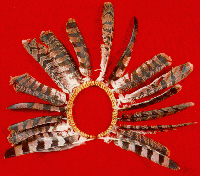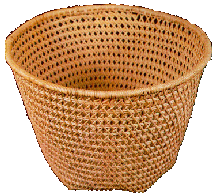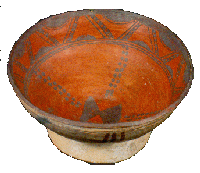 RAWAK
RAWAK RAWAK
RAWAK  |
The groups belonging to the language branch Arawak, in the Amazon, are the following: Baniva, Baré, Curripaco, Piapoco and Warekena. However, languages of groups that have long disappeared or that do not exist as such in the Federal Territory Amazonas, such as the tariana, yavitero and achagua, are still practiced. |
They are located in zones near San Fernando of Atabapo and the region of Guainía, Casiquiare and Black River.
"The soils of the high Black River are very acid and poor in nourishments even compared to Amazonic standards. Humid jungles in this region are relatively low (25-30 m. of height), and the diversity of the wild species is comparatively less than with forests in similar conditions of humidity and temperature. The research of recycling of nourishmensts in the land forests around San Carlos of Rio Negro proved that the gross mats of roots in the surface of the ground have the important function of capturing the nourishment made available by rain and vegetable and animal remains. Only a fraction of 1% of the free nourishments arrive to the soils under the root mat. In brief, the forest feeds itself by means of recycling the nourishments in narrowly closed way.
 |
The rivers which drain these forests contain very low levels of nourishments and a low productivity in situ of fitoplancton. Because of this fish and water animals depend mainly upon external sources located in the river banks. These are flooded in the rainy seasons and form bank areas of flooded jungle permitting the fish to enter a semi-terrestrial environment much richer in nourishment than the main river bed. |
Many fish species of black water rivers are capable of conserving energy surpluses in the form of grease through the exploitation of the alimentary reserves found in the banks. In the black water regions, the acuatic ecosystem supplies itself from the resources of the forest instead of depending on aluvional soils as is the case of the white water rivers. Trees, forest plants and river animals are subordinate to the narrowly closed recycling of the forest for its growth and regeneration. At the same time, the fish that eat fallen seeds from the trees and other plants along the rivers collaborate to disperse these seeds.
The indigenous groups in the Black River region are very conscious of the interdependence among the forest and the water, and because of this they prohibit explicit and unnecessary deforestation in the river banks. The Spaniard custom of cutting the vegetation in the river banks for their towns and ranches is a very dangerous practice for the environmental equilibrium of the Black River zones.
 |
The seasonal fluctuations are a great deal more extreme in the black water river systems than in the white ones, where the nourishment sources are richer and more stable. Generally, in the high Black River, and its affluent, there is a relative abundance of species in the dry stations, when the river is descending, and a brief period of superabundance in the following weeks to the first flooding during the spawning season. Because of the extent that the rivers continue to grow during the rainy season from from April to August, the fish and animal species extend over all the corners of the immense zone of flooded forests, and the main river remains almost void of animal life. |




©Todos los derechos reservados, se prohibe la
reproducción salvo permiso por escrito del autor.
©All rigths reserved, material duplication is prohibited
without written authorization by its author.